The Rehabilitation of John Dickinson, a Founder Forgotten No More
It is not too much to say that Dickinson’s biographer has been as dogged and heroic in getting at the truth of the American Revolution, its precursors and its aftermath, as Dickinson himself.

‘Penman of the Founding: A Biography of John Dickinson’
By Jane E. Calvert
Oxford University Press, 608 Pages
In 1767 and 1768, John Dickinson, in 12 letters published as “Letters from a Farmer in Pennsylvania,” made the case for an American identity separate from British rule. He was not arguing for independence but for a structure of dual sovereignty that Jane Calvert describes as “imperium, in imperio,” a state within a state, a concept of divided rule familiar to his Quaker neighbors but foreign to both the colonists and the British government.
What mattered in the 1760s is that Dickinson’s words — addressed to everyone and at a level comprehensible to any literate person — made a persuasive case that America had to be governed with a due respect for its own means of taxation and contributions to the British empire. He was a lawyer who was trained in England, where he realized that America would have to develop its own unique institutions that he hoped imperial authorities would respect.
Jane Calvert argues that Dickinson (1732-1808), a decade before the more famous Founders of what became the United States — before Thomas Paine and Thomas Jefferson, George Washington and John Adams — provided Americans with a justification for self-rule and persuasive arguments for a strong central government that he would put into the discarded first draft of the Articles of Confederation.
When Dickinson refused to sign the Declaration of Independence, he was attacked unjustly by no less than John Adams as not only recalcitrant in the cause of liberty but as a renegade and self-dealing operator.
Ms. Calvert’s biography is nothing less than a defense and rehabilitation of a patriot who foresaw how difficult it would be to establish a new nation, how liable it would be to foreign interference and debts that might possibly destroy it. Declaring independence was premature; eschewing an outright break with Britain was necessary in order to strengthen the forces of opposition to imperial power.
That Dickinson’s arguments did not win out, that many of his contemporaries condemned him, did not deter him from serving his new country. He accepted the results of the American Revolution, even as many of the new nation’s difficulties proved that his earlier concerns were merited. He served in many government offices in Pennsylvania and Delaware until very near the end of his life.
Dickinson’s merits, as Ms. Calvert impressively demonstrates, were prized in his own time even as attacks on his refusal to sign the Declaration of Independence never ceased. Not only did he restore a bankrupt Delaware to financial health, he curbed the factionalism rife in Pennsylvania as Quakers lost their hold on state government.
Married to a Quaker and strongly influenced by Quakerism, Dickinson held views that later became influential — such as the right to civil disobedience, respecting the laws but also protesting against them when they were deemed wrongful.
Dickinson was the only member of the founding generation to free his slaves while he was alive, and to argue more broadly for emancipation and even the social equality of Black and white Americans. At the same time, he followed the Quaker policy of conciliation with native Americans, respecting their rights and treating them as a sovereign people, and, unlike contemporaries such as John Adams, Dickinson championed the rights of women.
So why isn’t John Dickinson better known? Why isn’t he included in the American pantheon of leaders? Why haven’t there been biographies of him? Why, in short, has Ms. Calvert had to do all the work? (With the support, of course, of those named in her gracious acknowledgments.)
Dickinson had powerful enemies — not only John Adams, whose treatment of Dickinson was scurrilous, but Benjamin Franklin, who saw Dickinson as a rival who had to be out maneuvered.
The unassuming Dickinson, other than publishing collections of his famous “letters,” did little to burnish his legacy. He left a formidable but inaccessible archive that Jane Calvert has spent decades deciphering and making public.
It is not too much to say that Dickinson’s biographer has been as dogged and heroic in getting at the truth of the Revolution, its precursors and its aftermath, as Dickinson himself, who lived long enough to see and support a still struggling nation, built upon the principles he did so much to establish.
Mr. Rollyson is the author of the forthcoming “Making the American Presidency: How Biographers Shape History.”

